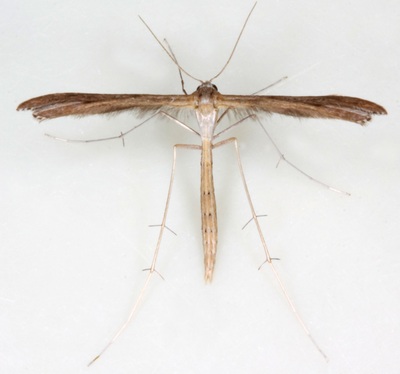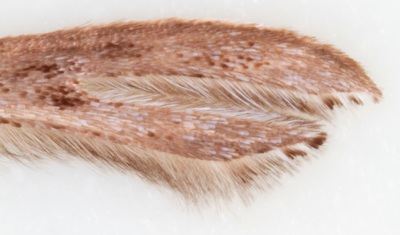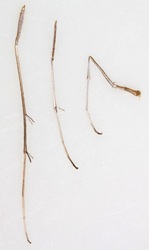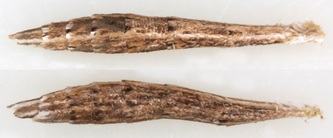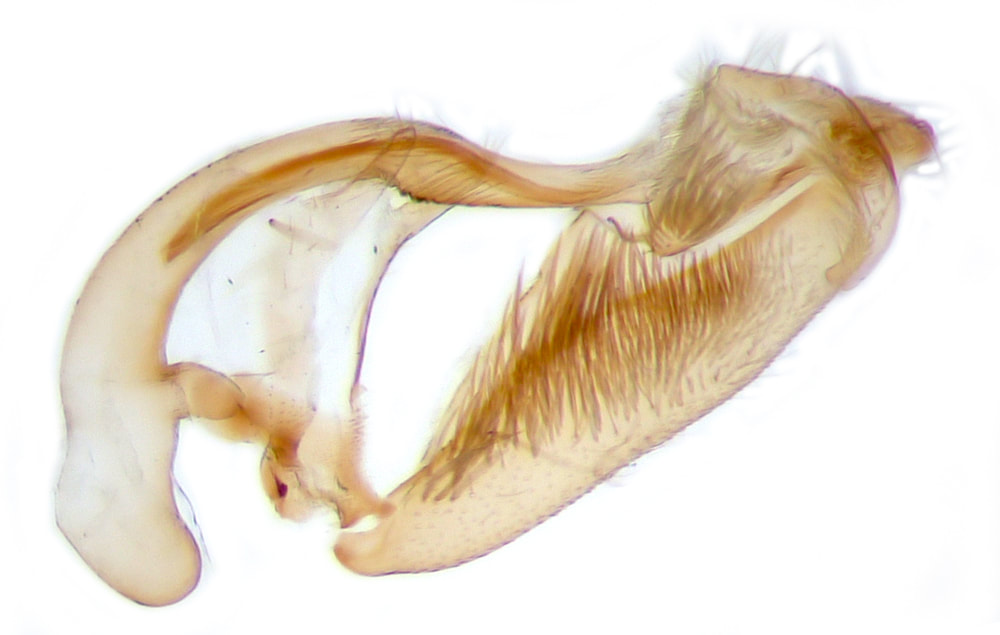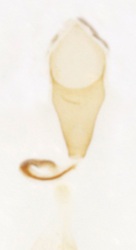45.021 Stenoptilia zophodactylus (Dowdy Plume)
ws: 16-23mm; Jul-Sep; common centaury (Centaurium erythraea), yellow-wort (Blackstonia perfoliata), Chiltern gentian (Gentiana germanica); local on sea-cliffs, sand-dunes and dry grassland England.
ID: See S.bipunctidactyla for an account of the external features that (probably won't) help in distinguishing this species from its congeners. The features given for S.zophodactylus are: forewing pale brown (but my specimens have been mostly mid-brown); the more costal of the 2 spots at base of cleft slightly proximal to the more dorsal spot (but the more costal spot is often not clearly defined); 1st lobe fringe with 2 spots at termen (probably true and this may be a good feature for separating from S.bipunctidactyla), 2nd lobe fringe with 2 spots in termen (possibly so, but could be interpreted as 3 spots in some of my specimens) . UKMoths states that this is the only British member of the genus with white legs and an all-white saddle - however, on comparing plates in Gielis and web images, the legs do not seem to me to be convincingly whiter than other species in the group (and my specimens certainly show brown femora and brown hindtibia) and the whiteness of the saddle seems variable at least in comparing S.bipunctidactyla and S.zophodactylus.
Currently, I would not confidently identify this species without genital dissection.
Male Genitalia: The only member of the genus in which the apex of the uncus does not reach the margin of the tegumen; and the only member of the genus with paired membranous projections at the corners of the apex of the tegumen (Hart refers to these as "socii" and they are labelled as such in the gallery below - but this label does not fit with Pierce's original description of socii as arising on either side of the base of the uncus).
Female Genitalia: The relevant details for separating the species are: shape of ostium bursae (OB); shape of antrum (the posterior sclerotised portion of ductus bursae (DB)); length of anterior membranous part of DB in relation to length of antrum; length of sclerotised bar in membranous part of DB.
S.pterodactyla: OB slightly excavated; antrum length 4-5x width; membranous DB = antrum length; sclerotised bar ~1/2 length of membranous DB.
S.bipunctidactlya: OB slightly excavated: antrum length 3x width; membranous DB 1.5x antrum length; sclerotised bar for nearly full length of membranous DB. (Confusion: although Gielis text states "membranous part of DB 1.5x as long as antrum", the plate shows the membranous DB shorter than the antrum. Dissection group does not have an image for female S.bipunctidactlya, but does indicate that its membranous DB is shorter than in S.pterodactlya).
S.aridus: can only be distinguished from S.bipunctidactlya by examination of female genitalia. Gielis text states "ostium asymmetrical" but the plate shows the ostium of S.bipunctidatlya as more asymmetrical. The antrum in the plate of S.aridus is drawn much smaller than that of S.bipunctidatyla though the overall proportions are similar. The membranous DB is drawn 1.5x longer than the antrum and it contains a sclerotised bar for 2/3 of its length.
S.annadactyla: OB slightly excavated; antrum with near parallel margins, length 1.5x width; membranous DB 2x antrum length; sclerotised bar for 1/2 length of membranous DB.
S.millieridactyla: OB rounded; antrum funnel-shaped, short; membranous DB 5-6x antrum length; slender sclerotised bar for most of its length.
S.islandica: ostium excavated with a lateral extension; antrum length 2x width; membranous DB 2x antrum length; broad sclerotised bar for 2/3 its length.
S.zophodactylus: Ostium rounded with an acute posterior portion; antrum length 3x width; membranous DB 1.5x antrum length; sclerotised bar for most of length of membranous DB.
The shape of the ostium is unlike any other Stenoptilia species and confirms the identity of specimen §3.
Specimens 1&2 look identical and were found in the same location at the same time of year, but their identity is not confirmed.
Currently, I would not confidently identify this species without genital dissection.
Male Genitalia: The only member of the genus in which the apex of the uncus does not reach the margin of the tegumen; and the only member of the genus with paired membranous projections at the corners of the apex of the tegumen (Hart refers to these as "socii" and they are labelled as such in the gallery below - but this label does not fit with Pierce's original description of socii as arising on either side of the base of the uncus).
Female Genitalia: The relevant details for separating the species are: shape of ostium bursae (OB); shape of antrum (the posterior sclerotised portion of ductus bursae (DB)); length of anterior membranous part of DB in relation to length of antrum; length of sclerotised bar in membranous part of DB.
S.pterodactyla: OB slightly excavated; antrum length 4-5x width; membranous DB = antrum length; sclerotised bar ~1/2 length of membranous DB.
S.bipunctidactlya: OB slightly excavated: antrum length 3x width; membranous DB 1.5x antrum length; sclerotised bar for nearly full length of membranous DB. (Confusion: although Gielis text states "membranous part of DB 1.5x as long as antrum", the plate shows the membranous DB shorter than the antrum. Dissection group does not have an image for female S.bipunctidactlya, but does indicate that its membranous DB is shorter than in S.pterodactlya).
S.aridus: can only be distinguished from S.bipunctidactlya by examination of female genitalia. Gielis text states "ostium asymmetrical" but the plate shows the ostium of S.bipunctidatlya as more asymmetrical. The antrum in the plate of S.aridus is drawn much smaller than that of S.bipunctidatyla though the overall proportions are similar. The membranous DB is drawn 1.5x longer than the antrum and it contains a sclerotised bar for 2/3 of its length.
S.annadactyla: OB slightly excavated; antrum with near parallel margins, length 1.5x width; membranous DB 2x antrum length; sclerotised bar for 1/2 length of membranous DB.
S.millieridactyla: OB rounded; antrum funnel-shaped, short; membranous DB 5-6x antrum length; slender sclerotised bar for most of its length.
S.islandica: ostium excavated with a lateral extension; antrum length 2x width; membranous DB 2x antrum length; broad sclerotised bar for 2/3 its length.
S.zophodactylus: Ostium rounded with an acute posterior portion; antrum length 3x width; membranous DB 1.5x antrum length; sclerotised bar for most of length of membranous DB.
The shape of the ostium is unlike any other Stenoptilia species and confirms the identity of specimen §3.
Specimens 1&2 look identical and were found in the same location at the same time of year, but their identity is not confirmed.
§1 St Marys, Isles of Scilly; 20/10/2007; fw 8.3mm
§2 St Marys, Isles of Scilly; 26/10/2007; fw 9.2mm
§3 St Marys, Isles of Scilly; 03/10/2011; female; fw 8.8mm
§4 Foulness, Essex; 26/07/2014; male; fw 9.9mm
§5 St Marys, Isles of Scilly; 27/09/2014; male; fw 8.3mm
§6 St Marys, Isles of Scilly; 13/10/2015; male; fw 9.4mm
§7 Dungeness, Kent; 12/07/2018; male; fw 8.4mm
§8 St Marys, Isles of Scilly; 09/10/2021; male
§9 St Marys, Isles of Scilly; 26/08/2022; male; fw 8.3mm
All images © Chris Lewis
§2 St Marys, Isles of Scilly; 26/10/2007; fw 9.2mm
§3 St Marys, Isles of Scilly; 03/10/2011; female; fw 8.8mm
§4 Foulness, Essex; 26/07/2014; male; fw 9.9mm
§5 St Marys, Isles of Scilly; 27/09/2014; male; fw 8.3mm
§6 St Marys, Isles of Scilly; 13/10/2015; male; fw 9.4mm
§7 Dungeness, Kent; 12/07/2018; male; fw 8.4mm
§8 St Marys, Isles of Scilly; 09/10/2021; male
§9 St Marys, Isles of Scilly; 26/08/2022; male; fw 8.3mm
All images © Chris Lewis
Page published 02/04/2012 (§1-3) | §4 added and text amended 15/08/2014 | §5 added 02/11/2014 | §6 added 01/11/2015 |
§7 added 25/05/2019 | §8 added 07/01/2022 | §9 added 02/12/2022
§7 added 25/05/2019 | §8 added 07/01/2022 | §9 added 02/12/2022




